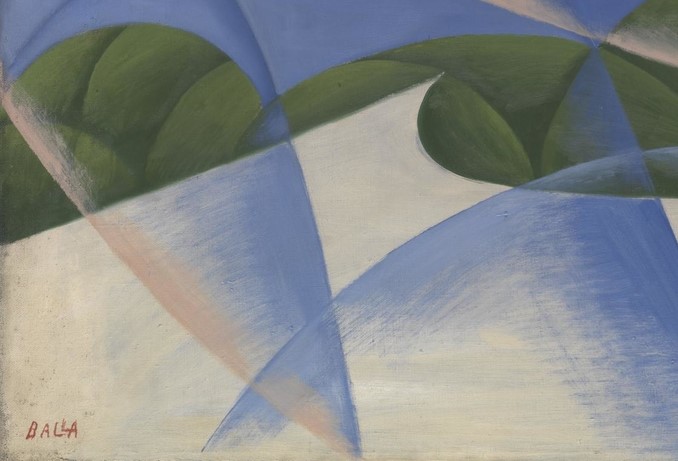
Abstract Speed – The Car has Passed is a painting created by Giacomo Ball in 1913. It is the 3rd part of a triptych along with the paintings Abstract Speed + Landscape (Velocità astratta + paesaggio), and Abstract Speed + Sound (Velocità astratta + rumore). The painting uses an abstract art style and is considered part of the Futurism art movement. Abstract Speed - The Car has Passed is currently located in the Tate Gallery in London.
Balla was dedicated to researching the phenomenon of movement. He is the author of numerous studies and paintings that examine the dynamism of movement in different forms. The triptych Abstract Speed, which Balla worked on between 1913 and 1914, is an example of a clearly defined futurist aesthetic based on a synthesis of cubist and post-impressionist influences. By contrasting a field of pure colors with very little space for nuanced tones, Balla laid a divisionist basis for the composition. A strong cubist impulse is felt in the application of mobile perspective as well as the geometrical fragmentarity that characterizes all three paintings. The futurist landscape loses the pastoral qualities of traditional landscape painting. It represents the dynamics of movement in nature, whether a landscape is one of the elements of the composition or an independent landscape in the case of aeropainting. In the case of the Abstract Speed triptych, it is about exploring the futurist idea of permeating all living and non-living elements in space. Giacomo Balla painted over frames, thus continuing the space of the painting beyond the space it traditionally occupies. In this way, Balla extracted the scene from the reality of the painting and brought it closer to the viewer.
What is Depicted in Abstract Speed – The Car has Passed
Abstract Speed – the Car has Passed is the final painting of the Abstract Speed Triptych. Abstract Speed – The Car has Passed completes the triptych by included traces of the exhaust fumes in the air left by the passing car.
Analysis
Abstract Speed – The Car has Passed concludes this vibrant triptych. The most reduced in the palette, this composition brings clear contours of the landscape, which coloristically follows the three-part structure of the scene through dominant blue, green, and white. The traces of the exhaust fumes in the air left by the passing car, presented in pale pink tones, are the only element that indicates the car’s recent presence in space.

By dealing with the visual components of the car’s absence, Balla directs the viewer to an intuitive relationship with the scene. This is exactly what he writes about together with Umberto Boccioni, Carlo Carrà, Luigi Russolo, and Gino Severini in the Technical Manifesto of Futurist Painting from 1910 :
In order to conceive and understand the novel beauties of a Futurist picture, the soul must be purified; the eye must be freed from its veil of atavism and culture, so that it may at last look upon Nature and not upon the museum as the one and only standard.
As soon as ever this result has been obtained, it will be readily admitted that brown tints have never coursed beneath our skin; it will be discovered that yellow shines forth in our flesh, that red blazes, and that green, blue, and violet dance upon it with untold charms, voluptuous and caressing.
Related Artworks
Abstract Speed – The Car Has Passed is part of a triptych of paintings by Balla along with the paintings Abstract Speed + Landscape (Velocità astratta + paesaggio), and Abstract Speed + Sound (Velocità astratta + rumore).
